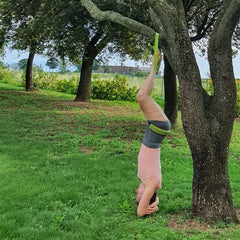Yoga, an ancient practice that promotes physical, mental, and spiritual well-being, offers a wide range of poses and techniques that can transform your life. One such pose is the suspended Sirsasana, a hallmark of Iyengar yoga. This pose provides a myriad of benefits and is often practiced using ropes and portable yoga slings, even from tree branches. In this article, we will explore the benefits of suspended Sirsasana in Iyengar yoga, the various techniques for practicing it with ropes, and the intriguing concept of using portable yoga slings on tree branches.
Benefits of Suspended Sirsasana in Iyengar Yoga:
Suspended Sirsasana, also known as the suspended headstand pose, is a distinctive yoga pose in Iyengar yoga that offers numerous benefits:
-
Improved Circulation: By inverting the body, this pose enhances circulation to the brain, which can improve mental clarity and alleviate stress.
-
Relaxation of Abdominal Organs: Unlike traditional Sirsasana where the arms are grounded, suspended Sirsasana allows the abdominal organs to relax fully. This can promote digestion and alleviate issues related to the abdominal region.
-
Spinal Alignment: Regular practice of suspended Sirsasana can assist in correcting misalignments in the spine, leading to improved posture.
-
Stress Reduction: The sense of calm and serenity experienced during suspended Sirsasana can reduce stress and anxiety levels.
Using Ropes for Suspended Sirsasana:
Using yoga ropes for Suspended Sirsasana in Iyengar yoga involves a specific setup that optimizes comfort and support for practitioners. Here are the essential steps to perform this pose using ropes:
-
Set Up the Ropes: Begin by securing two ropes hanging from wall hooks at shoulder level. These ropes should run parallel to each other.
-
Create a "Swing": Tie an additional rope to the two parallel ropes, creating a horizontal "swing" in the middle. This swing will serve as a supportive structure for your practice.
-
Prepare the Cushion: Place a yoga blanket on the horizontal rope swing. This will provide cushioning and support for your sacrum, the triangular bone at the base of your spine.
-
Position Yourself: Face the wall and approach the ropes. Position your sacrum against the yoga blanket on the swing, ensuring a comfortable and secure fit.
-
Climb the Wall: With your sacrum against the swing, gently climb the wall with your feet. Maintain a stable and balanced position while doing this.
-
Tilt Your Head: Once you're securely in place, gently tilt your head downward, allowing it to be supported by the ropes. Your legs should remain against the wall for added stability (check the video below to ensure you get it right and safe).
This setup optimizes the benefits of rope sirsasana by providing essential support and comfort for your practice, allowing you to focus on relaxation and alignment without straining your abdominal organs.
Here is a great step to step rope sirsasana teaching by the great Lois Steinberg:
Using a Portable Yoga Sling on Tree Branches:

Using a portable yoga sling on Tree Branches offers an adventurous twist to the traditional practice of suspended Sirsasana, allowing your arms and head to hang in a relaxed manner. Here's how to execute this unconventional pose, illustrated in the video below:
-
Select a Sturdy Branch: Begin by identifying a robust tree branch that can securely hold your weight. Ensure it's at a comfortable height for your practice.
-
Sling Setup: Secure a portable yoga sling around the chosen branch, making certain it is well-anchored and capable of supporting your body weight.
-
Safety Precautions: Prior to attempting the pose, conduct a thorough safety check to verify the stability of the sling and branch. Safety is paramount to prevent any accidents or mishaps.
-
Get into Position: Carefully position yourself within the yoga sling. Place your sacrum against the cushioned portion of the sling. Then, gently tilt backward, allowing your head to be cradled by the sling, all the while ensuring your arms and head hang in a relaxed and comfortable manner.
-
Utilize Your Legs: Use your legs as a brake against the sling, ensuring your body remains stable and balanced within the pose.
-
Practice with Awareness: Once you're securely positioned in the sling, practice suspended Sirsasana with mindfulness and focus, just as you would in a traditional setting. Pay attention to the relaxation of the abdominal organs, alignment, and your breath.
This approach to suspended Sirsasana allows for a unique experience, blending adventure with the serenity and benefits of this yoga pose. It is essential to maintain safety and comfort while enjoying this unconventional practice.
Rope Sirsasana in Iyengar yoga provides a unique approach to the iconic Headstand pose, offering numerous physical and mental benefits. Whether you choose to utilize ropes in a traditional studio setting or embrace the natural surroundings by suspending from tree branches, this pose can be a transformative addition to your yoga practice. Always prioritize safety, alignment, and proper technique to make the most of this invigorating yoga pose.
Click the link if you are looking for yoga ropes or yoga accessories online.

